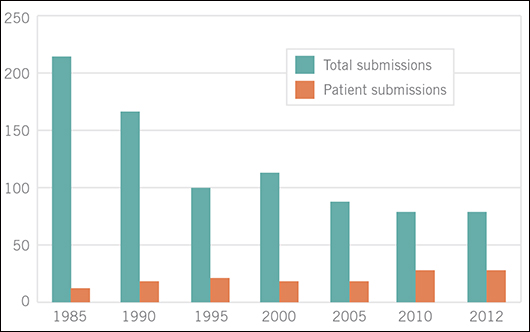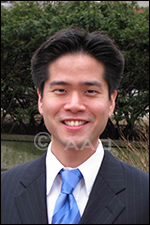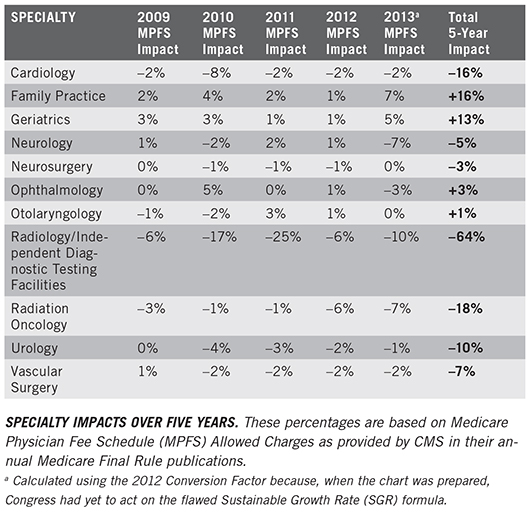What's Happening
Trends in Ethics Submissions
 |
| ETHICS SUBMISSIONS OVER TIME. The total number of submissions to the Ethics Committee has been trending downward since 1985. Patient care continues to be a major concern, however, with more and more submissions coming from patients themselves. (Source: Tabulation of submissions from the Ethics Committee database.) |
Over the last 10 years, the Academy’s Ethics Committee has seen a steady increase in patient submissions—both general ethics questions and reports of potentially unethical conduct by ophthalmologists. This increase is likely due to the Web and electronic communication, which enable patients to find the Ethics Committee online and facilitate the submission process.
Patient complaints often center on communication problems, the informed consent process, distrust of the doctor’s diagnoses and recommendations, failure of office staff to follow up on insurance issues, and delegation of patient care to office staff, among other grievances. Before responding to patients, the committee contacts the challenged ophthalmologist to gain his or her perspective. The Ethics Committee takes patient complaints very seriously because patient care connects the Academy to the public; therefore, it is important to investigate these complaints throroughly.
Despite the patient-submission statistics, overall submissions have continued to decrease, in part because the Ethics Committee works to lower the submission rate by adjudicating complaints of unethical behavior and educating members about the importance of ethics.
Adjudicating complaints. One of the most important roles of the Ethics Committee is to review submissions and determine whether and how to act on them. Anyone with a complaint about an ophthalmologist’s ethical conduct may send the Ethics Committee a submission form and supporting documentation. Formal submissions come from all sources: ophthalmologists, patients, patients’ families, an MD’s staff, attorneys, and state and federal agencies. Many are anonymous.
The subjects of submissions vary widely but can be narrowed down into the following general categories:
- Communications to the public
- Comanagement arrangements
- Patient care and relations
Educating members. The committee long ago determined that policing members’ activities was not an effective long-term method of meeting its goals; thus, it shifted its focus toward education. To address ethical issues facing residents and practicing ophthalmologists, the committee implemented the Bettman Ethics Education Lecture Series in 1993 and in 2004 created three online ethics courses. The courses use a dynamic approach for practitioners of all ages who require core ophthalmic knowledge in ethics. The committee also set goals for teaching medical ethics in the national and international arenas and will use the newly dedicated Michael R. Redmond, MD Professionalism and Ethics Education Center to accomplish these goals. The Academy is determined to remain a strong resource for its members in ethics training.
Questions regarding the Academy’s Ethics program may be answered at www.aao.org/ethics, or contact the ethics staff at ethics@aao.org.
Take Notice
Updated Guidelines for Femtosecond Laser Use in Medicare Billing
The Centers for Medicare & Medicaid Services recently released new femtosecond billing information. The Academy and the American Society of Cataract and Refractive Surgery released joint guidelines last year, which they have now updated to incorporate the new CMS information. The guidelines outline instances when billing for use of the laser is or is not clearly permissible.
To view the guidelines, visit www.aao.org/one, click the “News” tab, and search for the Nov. 28, 2012, news item, “CMS clarifies femtosecond Medicare billing.” A link to the guidelines is in the second paragraph.
Participate in Congressional Advocacy Day
To promote ophthalmology’s legislative agenda, attend the 2013 Congressional Advocacy Day (April 10-11), part of the Mid-Year Forum (April 10-13), in Washington, D.C. The event strengthens ophthalmology’s voice on Capitol Hill, builds support for key legislative issues, and ensures that federal laws and regulations promote quality eye care for patients. Members will be briefed on the issues and effective advocacy strategies prior to meetings with legislators. Registration is free and closes on March 18.
To learn more and to register online, visit www.aao.org/myf and select “Congressional Advocacy Day.”
 ONE SPOTLIGHT: YO Grand Rounds Winners. Congratulations to Yoshihiro Yonekawa, MD, of Massachusetts Eye and Ear Infirmary, who won first place in the Ophthalmic News and Education (ONE) Network’s YO Grand Rounds Competition. Dr. Yonekawa’s first-place entry describes a case of retinal detachment in a 4-year-old child with Sturge-Weber syndrome. Charlotte Gore, MD, of University of California at San Diego, won second place with a case report on bilateral vision loss following a lung transplant.To view the winning cases (and other cases by subspecialty), visit www.aao.org/one, click “Headlines” under the “News” tab, and search for “YO Grand Rounds Winners” from Nov. 18, 2012. ONE SPOTLIGHT: YO Grand Rounds Winners. Congratulations to Yoshihiro Yonekawa, MD, of Massachusetts Eye and Ear Infirmary, who won first place in the Ophthalmic News and Education (ONE) Network’s YO Grand Rounds Competition. Dr. Yonekawa’s first-place entry describes a case of retinal detachment in a 4-year-old child with Sturge-Weber syndrome. Charlotte Gore, MD, of University of California at San Diego, won second place with a case report on bilateral vision loss following a lung transplant.To view the winning cases (and other cases by subspecialty), visit www.aao.org/one, click “Headlines” under the “News” tab, and search for “YO Grand Rounds Winners” from Nov. 18, 2012. |
Academy Store
Protect Your Practice With Informed Consent
Building Best Practices for Informed Consent is a new online CME activity developed by the Academy in conjunction with the Ophthalmic Mutual Insurance Company (OMIC). This activity includes chart-review checklists, multiple-choice self-assessments, an online course, and procedure-specific forms that you can edit to fit your practice. Building Best Practices is ideal for new practices setting up their informed consent process, or for established practices looking to re-examine and strengthen existing procedures.
The activity (#022012V) is $100 for members, $130 for nonmembers. Those who complete the activity will also earn a 5 percent risk management discount on OMIC membership.
To purchase, visit www.aao.org/store.
Need a Certified Ophthalmic Assistant?
The Academy’s multistep program helps aspiring certified ophthalmic assistants (COAs) learn skills to join the patient care team.
- Learn about the COA’s role in screening, diagnosis, surgery, and more. The textbook Ophthalmic Medical Assisting: An Independent Study Course contains illustrated, step-by-step reviews of 44 common procedures an ophthalmic assistant needs to know about (#0211215, or #0211205V when purchased with the online exam below).
- Test what was learned. After reviewing the textbook, take the Ophthalmic Medical Assisting: An Independent Study Course online exam. A score of 80 percent or higher is a prerequisite for the COA exam administered by the Joint Commission on Allied Health Personnel in Ophthalmology (JCAHPO) (#0211225V, or #0211205V when purchased with the textbook).
- Prepare for the live certification exam. The Academy’s Certified Ophthalmic Assistant Exam Study Guide has 300 multiple-choice study questions and a practice exam with 100 additional questions. Available in print (#0242409) or online (#0242408V), or buy both and save (#0242410).
- Complete the COA exam. Register for the exam at www.jcahpo.org, where you can learn more about the certification process.
To view pricing or to purchase, visit www.aao.org/store.
2013 Coding Update Webinar
On Jan. 8, the American Academy of Ophthalmic Executives (AAOE) held its 2013 Ophthalmology Coding Update webinar. The session covered this year’s updates to ophthalmic coding and reimbursement affecting your practice. If you were unable to attend, you can order the recording of the webinar. Topics include the following:
- Implementation of new CPT and ICD-9 codes
- PQRS and e-prescribing changes
- Impact of fee schedule changes
A CD or online multimedia recording (access for 60 days) is $185 for members, $236 for nonmembers.
For more information, visit www.aao.org/aaoeevents.
Find CPT Codes
Code quickly and precisely with the revised 2013 CPT Pocket Guide for Ophthalmology (#0120334). This compact book contains only ophthalmic-specific CPT codes and descriptions so you can find the procedural codes you need.
The book is $43 for members, $70 for nonmembers.
For more information, visit www.aao.org/codingproducts.
Use Customizable Presentations
Make compelling presentations to patients, community groups, and nonophthalmic health professionals without creating slides from scratch. The Academy’s two customizable PowerPoint presentations on CD come with high-quality animations, full-color illustrations and photographs, and more. Choose from Advances in Refractive Surgery, 2nd edition (#054126) and The Eye Over Time, 2nd edition (#054127).
Each CD is $199 for members, $268 for nonmembers.
For more information, visit www.aao.org/store.
Meeting Matters
Save the Date: New Orleans 2013
The Academy will return to the Ernest N. Morial Convention Center in New Orleans for its 2013 Annual Meeting from Nov. 16 to 19. Subspecialty Day meetings will take place Nov. 15 and 16.
For more information, visit www.aao.org/2013.
Paper/Poster and Video Submission Deadline
If you are interested in being a presenter at the 2013 Annual Meeting, you must submit abstracts online. Please review the abstract guidelines before making your submission.
For papers, posters, and videos, the online submitter opens on March 13 and closes on April 9.
For abstract guidelines, go to www.aao.org/annual-meeting and select "Presenter Central." For further information, e-mail meetings@aao.org.
International Attendees
Now is the time to make sure your travel documents are up to date for this year’s Annual Meeting and Subspecialty Day in New Orleans. Visa applications should be made no later than 90 days prior to travel.
Travelers from countries participating in the Visa Waiver Program (VWP) must complete an Electronic System for Travel Authorization (ESTA) application and receive notification of acceptance prior to departure.
For more information and to access other Annual Meeting travel information, visit www.aao.org/2013.
2012 Joint Meeting Archives
Visit the Meeting Archives to download course handouts, see scientific posters, view highlights from the Opening Session, and more. You can also purchase more than 200 hours of content from the 2012 Joint Meeting through AAO Meetings on Demand.
For more information, visit www.aao.org/aao-archives or www.aao.org/ondemand.
D.C. Report
2013 Medicare Payments for Ophthalmologists
The 2013 Medicare Physician Fee Schedule included disheartening news for ophthalmology. The Centers for Medicare & Medicaid Services (CMS) had performed a review to identify misvalued services, and, as a result, the agency decided to reduce payment for cataract services as of Jan. 1. CMS’s decision is based on data from a CMS-mandated nationwide survey of ophthalmologists, conducted jointly by the Academy and the American Society of Cataract and Refractive Surgery. (The survey was designed by the American Medical Association [AMA] Relative Value Scale Update Committee [RUC] and is used by all specialties for surgeries with a 90-day postop period.)
The results indicate that the intraservice surgical time for CPT Code 66984 Extracapsular cataract removal with insertion of intraocular lens has decreased by nearly 10 minutes from the 30-minute time frame identified in a 2005 survey. The RUC survey also showed that, when compared with the last data gathered in 2000, the intraservice surgical time for CPT Code 66982 Complex cataract removal with insertion of intraocular lens has decreased from 60 minutes to 30 minutes and has one less postoperative visit in the global period.
As a result, the RUC recommended to CMS reduced physician-work and practice expense values for these procedures. Based on the 2012 payment rate, the reduction for CPT Code 66984 is approximately 14 percent, and for CPT Code 66982 it is approximately 21 percent. CMS estimates that the overall impact on payments to ophthalmologists will be about 3 percent. “The RUC value update process is increasingly rigorous in terms of the data presented. Unfortunately, the amount of time taken to perform the service is too often the most important factor the RUC considers when debating a value. As a result, stress, risk, and outcome are often ignored as factors,” said Michael X. Repka, MD, Academy medical director for Governmental Affairs.
For the last five years, CMS has engaged the RUC to conduct targeted code reviews of procedures that the agency believes are misvalued. As a result, nearly all specialties across the board have experienced reductions—ophthalmology is not unique. Despite this year’s change to cataract surgery reimbursements, ophthalmologists in general have fared better than many physicians, as ophthalmologists have seen a cumulative 3 percent positive impact from Medicare-allowed charges since 2009. Unlike ophthalmology, many procedural specialties have seen double-digit reductions in allowed Medicare charges since then, including radiology (64 percent), cardiology (16 percent), and urology (10 percent).
Based on results from past Physician Practice Information Surveys, CMS initiated four years of increases in practice expense payments for eye care services, while other specialties were cut. Ophthalmology’s payments have been relatively insulated from cuts because the Academy successfully advocated for the AMA to resurvey practice expenses attributable to all physicians. In addition, the Academy was successful in securing equity for Eye Visit codes when CMS increased Evaluation and Management codes for primary care.
The RUC estimates that since 2009, CMS has redistributed $2.5 billion from the specialties to primary care. The 2013 reduction in payments for cataract surgery to ophthalmologists amounts to about 7.5 percent of that figure. Ophthalmology continues to maintain a positive balance overall, however, because of increases to payments for practice expenses and office visits.

Members at Large
Passages
Conor C. O’Malley, MD, a retired eye surgeon known for his groundbreaking innovations in surgical equipment, died on Nov. 30. He was 82.
Dr. O’Malley was well-known for coinventing Ocutome, a system of instruments for intraocular microsurgery now used by ophthalmologists worldwide. The technology has helped thousands of people regain their eyesight.
“His main contribution to humanity was recognizing that many tiny incisions were far less traumatic than one or two large ones. This is the basis of the global use of minimally invasive surgery. This was an enormous contribution to surgery overall,” said his brother, Patrick O’Malley, MD.